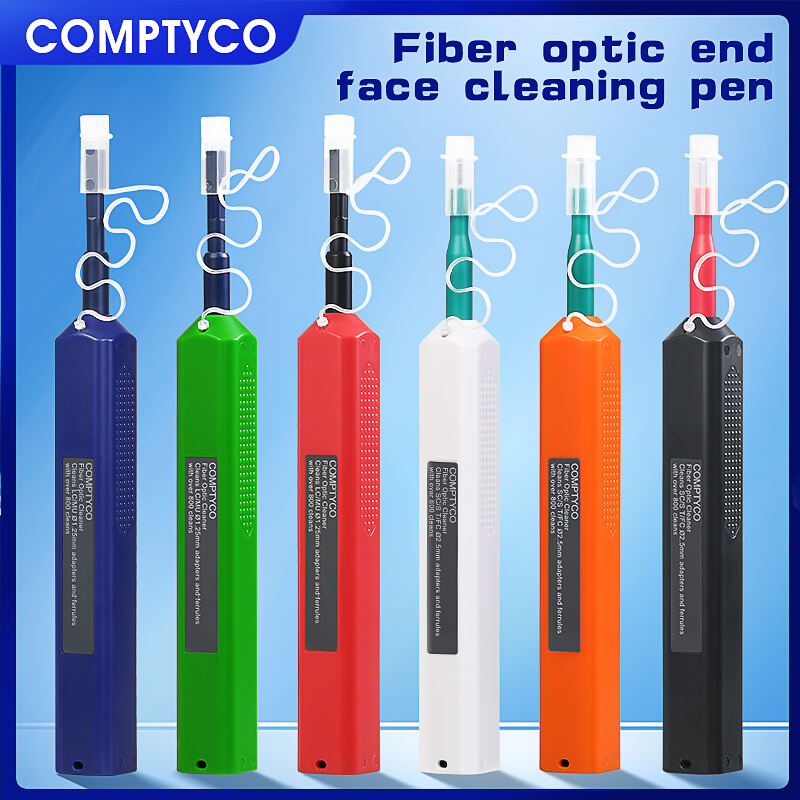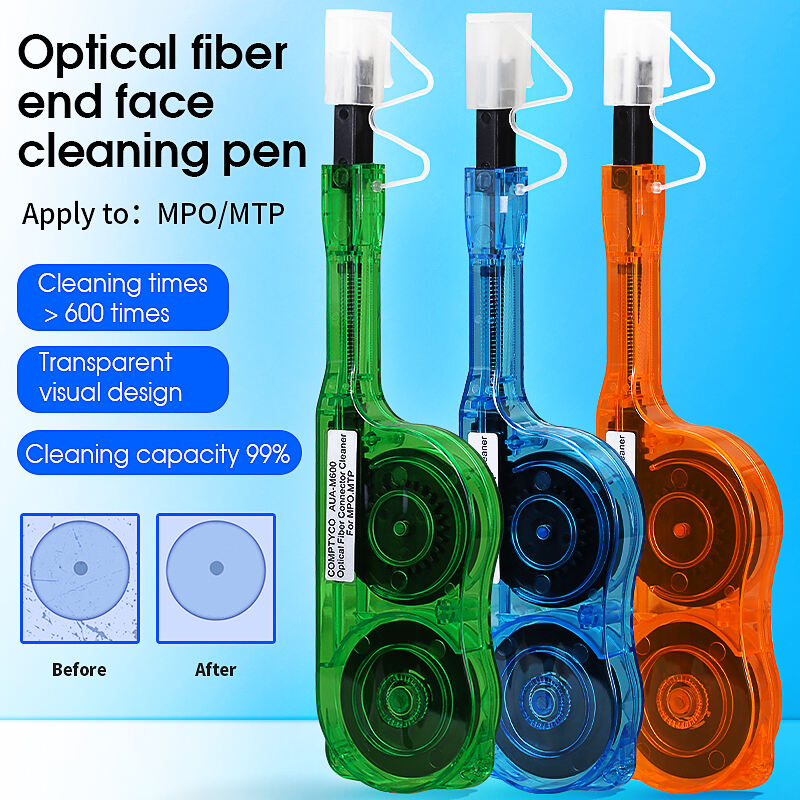Understanding the Critical Role of Fiber Optic Cleaning Solutions
In the world of telecommunications and data transmission, maintaining pristine fiber optic connections is paramount. A fiber optic cleaner serves as the cornerstone of network reliability, ensuring optimal signal transmission and preventing costly downtime. Modern networks demand increasingly precise cleaning solutions to maintain their integrity, making the selection of appropriate cleaning tools more crucial than ever.
The telecommunications industry has witnessed a significant evolution in cleaning technologies, from simple alcohol wipes to sophisticated fiber optic cleaner devices designed for specific connector types. Understanding these advancements and their applications can make the difference between a network that performs at peak efficiency and one that struggles with signal loss and intermittent failures.
Essential Components of Professional Fiber Cleaning Solutions
Wet Cleaning Systems and Their Applications
Professional wet cleaning systems represent a sophisticated approach to fiber optic maintenance. These solutions typically include specialized solvents designed to dissolve and remove stubborn contaminants without leaving residue. When selecting a fiber optic cleaner that uses wet cleaning technology, it's essential to consider the evaporation rate and cleaning effectiveness of the solution.
The most effective wet cleaning systems combine fast-drying solvents with anti-static properties, ensuring thorough contamination removal while preventing static charge buildup that could attract new particles. These systems often come with precision dispensing mechanisms to control solvent application, preventing over-saturation that could lead to residue formation.
Dry Cleaning Tools and Technologies
Dry cleaning solutions offer unique advantages in certain scenarios, particularly for quick maintenance operations. Modern fiber optic cleaner tools in this category utilize advanced materials like microfiber and specialized fabrics designed to trap and remove particles effectively. These solutions are engineered to maintain consistent cleaning performance without introducing new contaminants to the connector surface.
The latest dry cleaning technologies incorporate mechanical innovations that ensure even pressure distribution and proper cleaning motion across the connector face. This attention to detail helps prevent damage while ensuring thorough contamination removal from critical areas of the connector.

Matching Cleaners to Connector Types
Single Fiber Connector Solutions
Selecting the appropriate fiber optic cleaner for single fiber connectors requires careful consideration of the connector's physical characteristics. SC, LC, and ST connectors each present unique cleaning challenges due to their specific designs and dimensions. Modern cleaning solutions often feature adjustable tips or specialized attachments designed to accommodate these variations effectively.
The most versatile single fiber cleaning tools incorporate universal adapters that can handle multiple connector types without compromising cleaning effectiveness. This adaptability proves particularly valuable in environments where technicians encounter various connector styles regularly.
Multi-fiber Connector Considerations
Multi-fiber connectors, such as MPO/MTP configurations, demand specialized cleaning approaches due to their complex geometry and multiple connection points. A fiber optic cleaner designed for these applications must address the unique challenges of cleaning multiple fiber ends simultaneously while maintaining consistent results across all connections.
Advanced cleaning solutions for multi-fiber connectors often incorporate innovative features like automated alignment mechanisms and specialized cleaning paths that ensure thorough contamination removal across the entire connector face. These tools frequently utilize custom-designed cleaning materials that can effectively clean multiple fibers in a single operation.
Environmental Factors and Cleaning Requirements
Climate-Specific Considerations
Environmental conditions significantly influence the selection of an appropriate fiber optic cleaner. High-humidity environments may require cleaning solutions with enhanced moisture-resistant properties, while extreme temperature conditions necessitate cleaning materials that maintain their effectiveness across a broad temperature range.
In challenging environmental conditions, the stability and reliability of cleaning solutions become paramount. Advanced fiber optic cleaner products often incorporate specialized packaging and delivery systems designed to maintain cleaning effectiveness regardless of environmental challenges.
Installation Location Impact
The physical location of fiber optic installations plays a crucial role in determining the most suitable cleaning approach. Indoor installations in controlled environments may allow for more delicate cleaning solutions, while outdoor or industrial settings often require more robust and portable fiber optic cleaner options.
Modern cleaning solutions address these varying requirements through innovative design features like sealed cleaning mechanisms, protective cases, and contamination-resistant materials. These adaptations ensure consistent cleaning performance across diverse installation scenarios.
Maintenance Protocols and Best Practices
Regular Cleaning Schedules
Establishing effective maintenance protocols requires careful consideration of cleaning frequency and methodology. A systematic approach to fiber optic cleaner application helps prevent signal degradation and extends connector life. Regular inspection and cleaning schedules should be tailored to the specific environment and usage patterns of the network.
Professional maintenance programs often incorporate automated reminder systems and documentation procedures to ensure consistent cleaning practices. These protocols typically specify the appropriate fiber optic cleaner type for each connector and situation, minimizing the risk of improper cleaning techniques.
Emergency Cleaning Procedures
Emergency situations require rapid but careful cleaning responses to restore network functionality. Having appropriate fiber optic cleaner solutions readily available and establishing clear emergency cleaning procedures helps minimize network downtime while ensuring proper cleaning techniques are maintained even under pressure.
Advanced cleaning kits often include quick-reference guides and emergency response protocols, ensuring that even in urgent situations, proper cleaning procedures are followed. These kits typically contain multiple cleaning options suitable for various emergency scenarios.
Frequently Asked Questions
What features should I look for in a professional fiber optic cleaner?
When selecting a professional fiber optic cleaner, look for features such as compatibility with multiple connector types, effective contamination removal capability, and durability. The cleaner should also include safety features to prevent damage to connectors and offer consistent cleaning results. Consider options with replaceable cleaning elements and verify that the cleaning solution meets industry standards for residue-free operation.
How often should fiber optic connections be cleaned?
The frequency of cleaning depends on several factors, including the environment, usage patterns, and connector type. As a general rule, clean connections before every new mating and during regular maintenance intervals. In dusty or industrial environments, more frequent cleaning may be necessary. Always inspect connections before cleaning to avoid unnecessary intervention.
Can I use alternative cleaning solutions when a specialized fiber optic cleaner is unavailable?
It's strongly recommended to use only approved fiber optic cleaner products designed specifically for optical connections. Alternative solutions may leave residue, cause damage, or fail to remove contaminants effectively. In emergency situations, consult with equipment manufacturers or industry specialists for approved temporary solutions, but always plan to have proper cleaning tools available.







